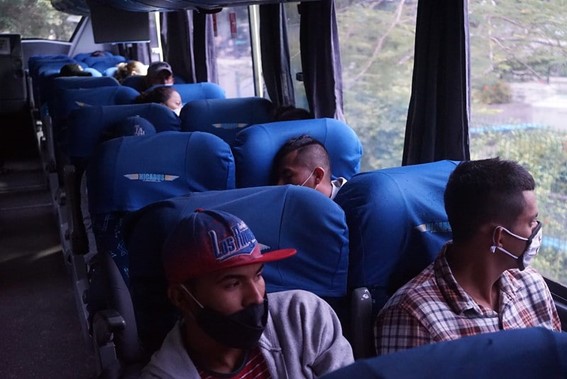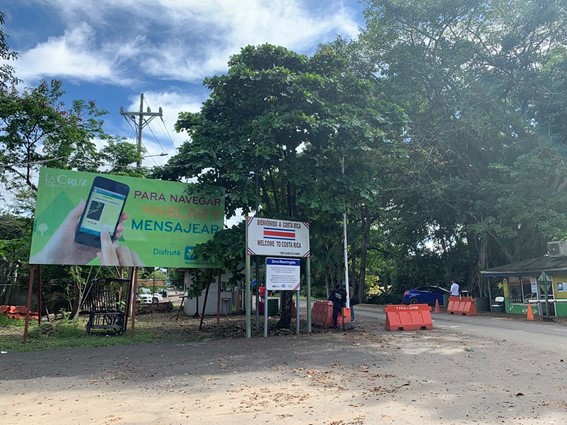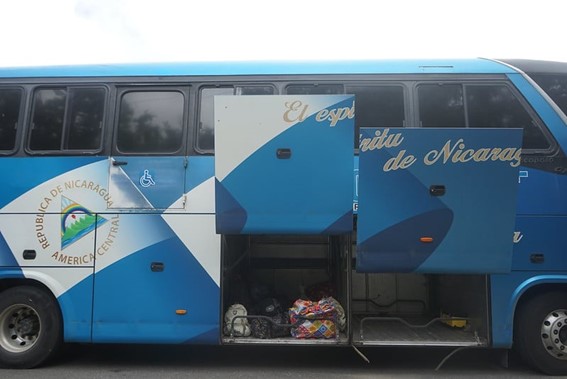Travel Guide between Nicaragua and Costa Rica
With the Covid-19 restrictions

What you need to know about the different requirements, restrictions, and options for traveling between Nicaragua and Costa Rica.
By Cindy Regidor / Katherine Estrada (Confidencial)
HAVANA TIMES – The pandemic has reduced the ease of traveling from one country to another. There are fewer border restrictions now than when the pandemic first began in March 2020. However, those wanting to travel still face many limits.
Between Nicaragua and Costa Rica, the situation is no different. Transport options decreased for the thousands of Nicaraguans in Costa Rica used to shuttling freely between countries. Things have also grown more difficult for the family members that visit them, and for Nicaraguan and Costa Rican tourists. Also affected are those traveling on business. The problems extend to travelers from other countries, visitors who previously crossed borders easily, in buses or planes.
The airlines and travel companies have been reactivating little by little, adapting themselves to the new reality. At the same time, the number of travelers seeking to go from one country to another has slowly begun growing. In response, Confidencial has elaborated a guide for travel between Nicaragua and Costa Rica. Despite their differences, these two countries share strong ties, and remain socially and economically interdependent.
Who can enter Costa Rica?
Costa Rica sealed its borders completely, beginning in March of 2020. For a number of months, only citizens and legal residents could enter the country. Those returning had to fulfill the regulations indicated by the health ministry. Legal residents inside the country can’t leave, under penalty of forfeiting their immigration status.
In August 2020, the country began gradually reopening its air and sea borders to certain countries. In November, these borders reopened to all, including Nicaraguans. Tourists, residents, and citizens can all enter the country by ship or plane.
The land borders with Nicaragua and Panama remain closed to tourists until at least February 1, 2021. However, Costa Rican citizens, and temporary or permanent residents can now enter by land. Also permitted are those who work on international merchant vessels or cargo transport. In addition, controls allow selected Nicaraguan agricultural workers to enter. An agreement signed in December established procedures for the entrance of these migrant laborers.
Commercial and charter flights
Currently, only one international airline – Avianca – has resumed regular flights from Nicaragua to Costa Rica. The airline connects Managua and San Jose, with a stop in San Salvador. Currently, the airline confirmed, there are three flights a week: Monday and Friday afternoons, and Tuesday mornings.
Price and availability of these flights are subject to change, according to the date of purchase. Prices vary according to demand, and to how far in advance the ticket is purchased. An online survey of prices for different dates in February and March yielded a round-trip ticket cost between US $500-$700 dollars.
Charter flights are another option offered by travel agencies and tour operators. The companies rent an airplane for making the trip and then sell tickets to their customers. The dates and fares are announced on social media, and vary from one company to the other. According to a survey the roundtrip options, tickets for a January charter flight started at US $455 dollars.
Overland travel to Costa Rica for citizens or legal residents
After several months of closures, some bus travel companies have resumed their trips. However, they’re running on a greatly reduced schedule, compared to the pre-pandemic frequency. Before the pandemic, bus companies averaged two or more departures daily.
- Ticabus is charging US $29 for a one-way ticket from Nicaragua to Costa Rica, $58 round trip. The trip frequency has still not been determined. Rather, they’re scheduling specific dates in the month.
- Nicabus leaves Nicaragua twice a week for Costa Rica. Roundtrip tickets are US $57.50 for Managua departures and $80.50 for those traveling from Chinandega.
- Transnica is charging US $29.50 for a one-way ticket to Costa Rica, and US $59 round trip.
- In the Central Line, the cost of a ticket is US $25 one way and $50 round trip. The buses leave Nicaragua for Costa Rica twice a week, on Tuesdays and Saturdays.
Requirements for entering Costa Rica
The new entry requirements for Costa Rica are part of the country’s preventive measures during the pandemic. They include an online health pass that must be completed 48 hours before travel.

Those arriving in Costa Rica by air don’t need to present a negative Covid-19 test. This requirement was discontinued on October 26, 2020. However, they must show proof of current medical insurance.
Tourists should be ready to document their enrollment in national or international insurance plans. The plans should be able to cover the expenses of lodging and treatment if they were infected with the virus. For the uninsured, Costa Rica offers temporary local insurance that can be purchased. The price varies according to the number of days the person is staying.
Residents are asked to show that they’re up to date with their payments to the Costa Rican Social Security Registry (CCSS). If not, they must purchase temporary local insurance for a 22-day period. They are then issued a notice to catch up with the CCSS payments they owe.
For tourists, there are several options for purchasing temporary insurance policies. Agencies accredited by the Costa Rican Tourism Institute include the Costa Rican National Insurance Institute and “Sagicor” tourist insurance. The cost for temporary health insurance begins at about US $11.30 a day.
Quarantine and other requirements for land arrivals
Those who come to Costa Rica by air are not asked to quarantine. However, those entering by land must isolate for 14 days.
Proof of current health insurance and the health pass mentioned are other requirements for those arriving by land. In addition, Costa Rica maintains its normal requirements for entering the country. These vary according to the traveler’s nationality, but should be reviewed and complied with.
Travel from Costa Rica to Nicaragua
Anyone can enter Nicaragua from Costa Rica, since Nicaragua never officially closed its borders for the pandemic. Travelers – be they foreigners, Nicaraguan residents or citizens – can enter from Costa Rica or any other country,

What routes can be used to enter Nicaragua?
Nicaragua can be reached by air, sea or land routes. Currently the only available commercial option for air travel is Avianca airlines. They are making three flights a week, with a stop in El Salvador.
In addition, there are charter flights offered through travel agencies and tour companies. A survey of online information reveals one of them offering a roundtrip ticket for US $455. There are only two dates in January for these flights.
- In Ticabus: A one-way ticket to Nicaragua from Costa Rica costs US $28.75. The return trip to Costa Rica is worth $25 dollars more, for a total of US $53.75. The company posts specific dates in the month when they’ll be traveling, generally twice a week.
- Nicabus leaves Costa Rica for Nicaragua twice a week, on Saturdays and Sundays. A one-way ticket to Managua costs $28.75; a ticket to Chinandega costs $35.
- Transnica offers tickets for US $29.50 each way, $59 round trip. They have set only 5 departure dates in January.
- Central Line tickets cost US $25 each way, $50 round trip. They leave Costa Rica for Nicaragua twice a week, on Thursdays and Sundays.
Buses require masks and hand washing
All of the bus companies must comply with the protocols of the Costa Rican Health Ministry. These include wearing a mask during the entire trip, washing hands and using hand sanitizer.
Before the pandemic, there were people who made the trip to Nicaragua by changing buses at the border. That is, they would take a local bus from San Jose to Peñas Blancas,. Then they would cross the border on foot, and continue their trip by flagging a local bus in Nicaragua. The Deldu company, which runs buses to the Costa Rican border, have resumed this route. The cost of this part of the trip is 5030 Costa Rican colones, worth about US $8.23.
It’s important to recall that foreigners without residency or other Costa Rican immigration status can’t return by land, if they leave Costa Rica. The country is still not allowing foreigners to enter as tourists, except by air.
Negative COVID-19 test required to enter Nicaragua
All passengers, including children, who travel to Nicaragua must present proof of a current, negative COVID-19 test. This applies to all ports of entry, be it air, land or sea. Those wishing to enter must show proof of negative results on a PCR COVID-19 test, taken within 72 hours. No one can enter the country without this.
For those flying with Avianca, the below link gives the requirements and procedures for sending the test results: https://www.avianca.com/us/en/about-us/news-center/avianca-news/requirements-travelers-nicaragua/
In the case of the bus companies, passengers must submit a printed copy of the results of a COVID-19 test. This must be shown before boarding any bus to the border. Staff will verify the negative result and the test date and time. The test must have been administered within 72 hours of the moment the bus crosses into Nicaragua.
At the point of exit from Costa Rica, authorities there will also demand to see the negative Covid test result. This is only a requirement if the traveler is heading to Nicaragua.
Cost of the test
In contrast to Nicaragua, where the government alone conducts and processes all Coronavirus tests, there are private laboratories in Costa Rica. These labs can administer and process the standard PCR Covid-19 test. These are offered at different prices. Some of the bus companies have partnered with the laboratories to offer discounted tests. In such cases, passengers would be asked to present their bus ticket to the laboratory to qualify for a special price.
The general cost of the test runs from 41,600 colones [US $68] up to 59,000 colones [US $96.58].
Other requirements for entering Nicaragua include visas and tourist entry fees that vary according to the traveler’s nationality. Foreigners are also asked to fill out a form seven days prior to the trip.





